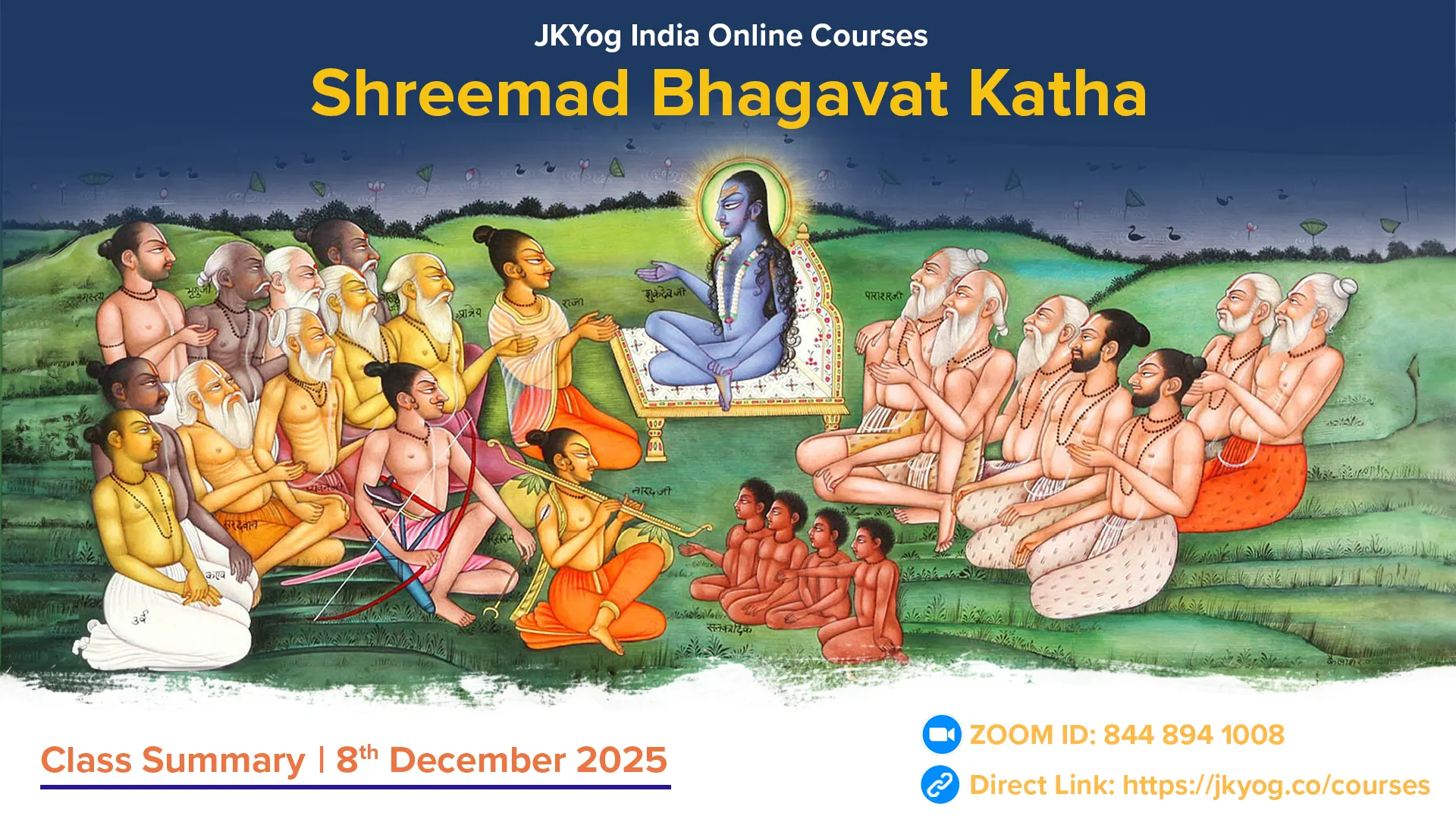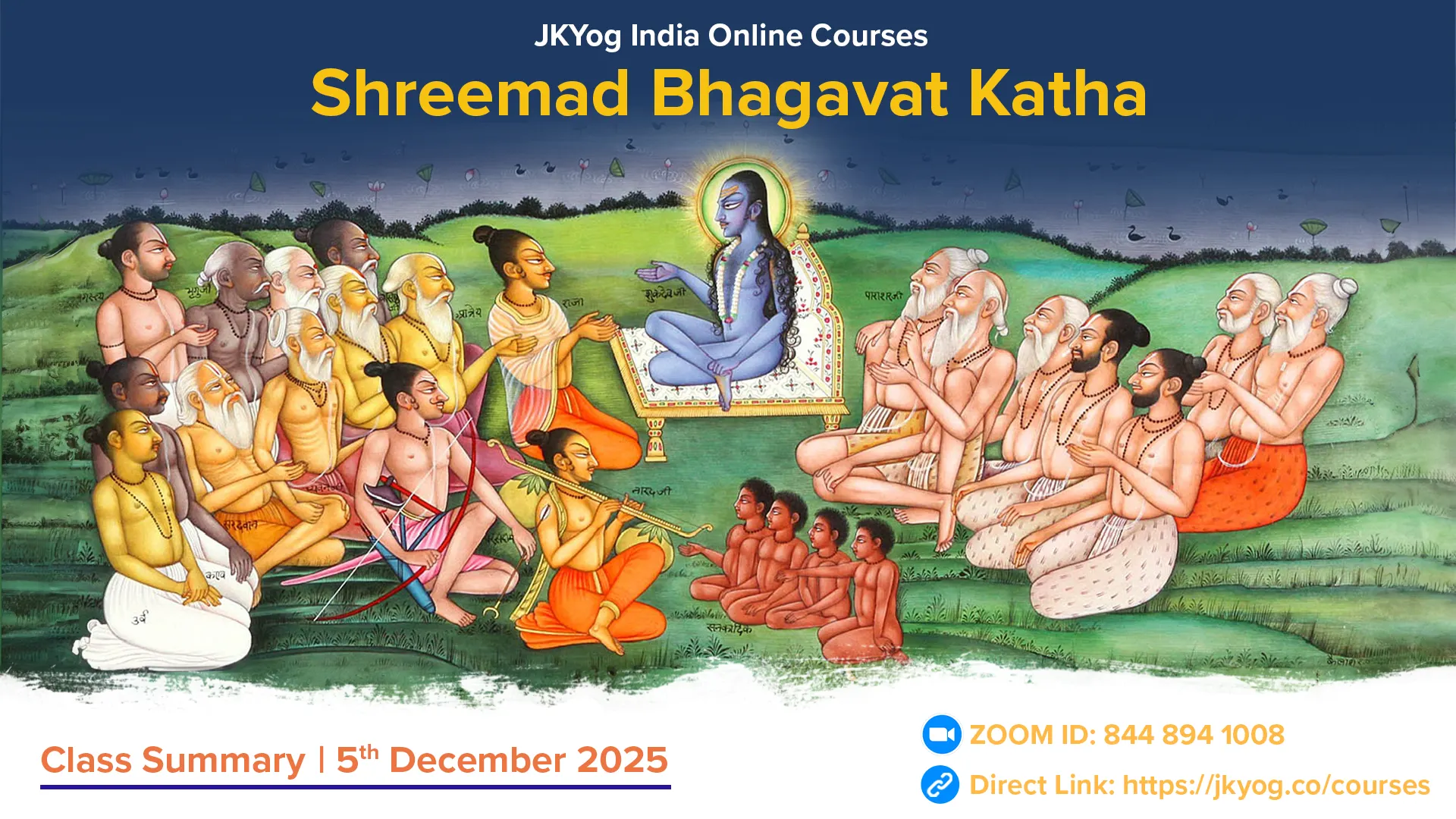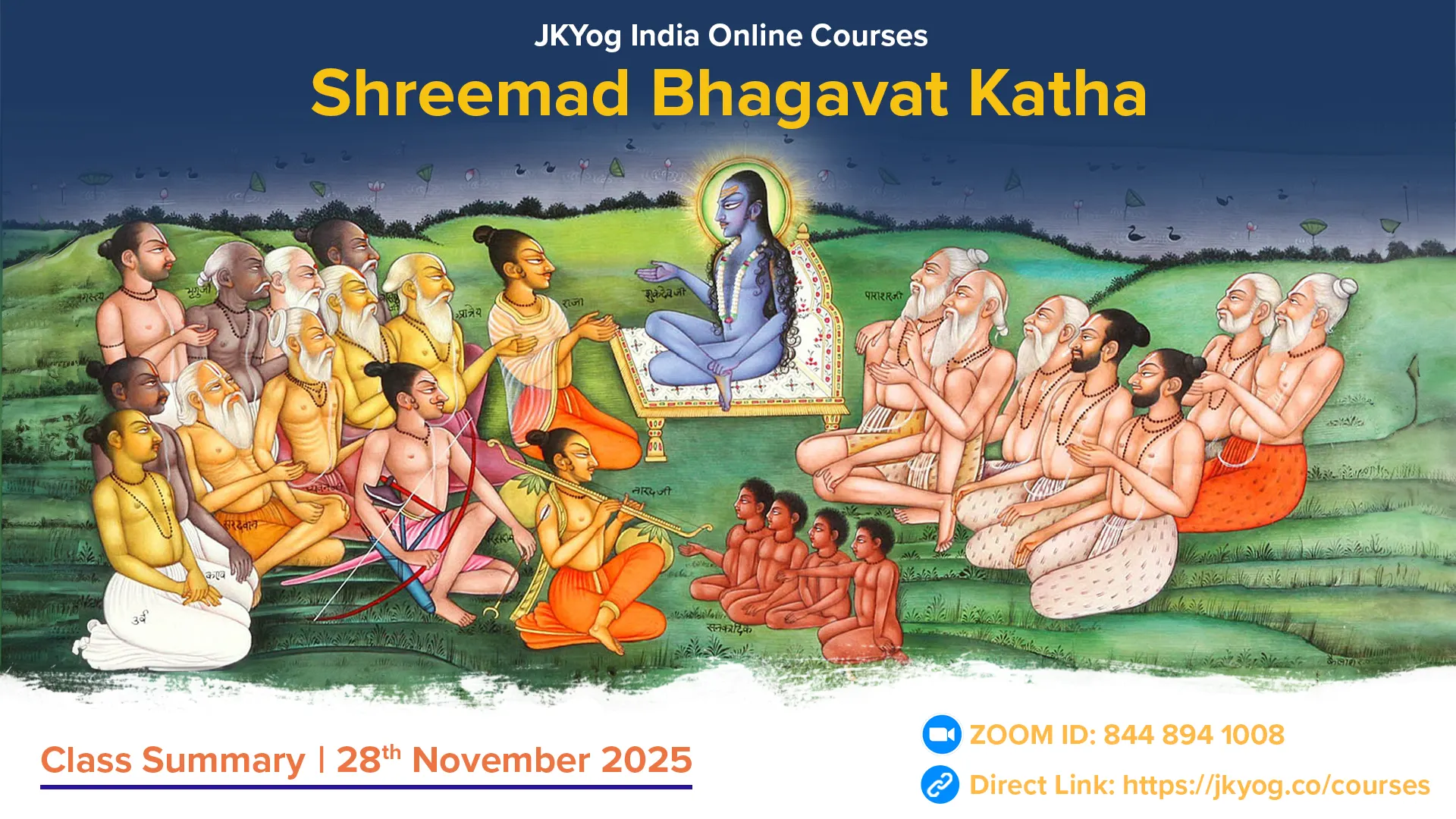Shreemad Bhagavat Mahapuran- Canto: 3, Chapters: 26 & 27
Sankhya Philosophy -The Origin and Transformation of Mahattattva and Ahankara, Attainment of Liberation through Knowledge of Prakriti and Purush.
In the beginning, Prakriti (made of maya shakti) existed in a calm and balanced state. When the Supreme Being, the Param Purush, who is the ultimate source of all beings, perceives the disturbance or agitation arising due to the unseen forces of living beings’ adrishta (karm), He infuses His conscious energy (chit-shakti) into Prakriti. With the infusion of this chit-shakti, the Mahatattva comes into being.
What is Mahatattva?
Mahatattva is the first and foremost element of creation, described as hiranyamaya (golden-like), symbolising its divine, radiant, and subtle nature. It serves as the foundation from which all other elements of creation emerge. Within the Mahatattva, the entire universe exists in seed form, ready to manifest. One of the key attributes of Mahatattva is that it is free from any disturbance or disruption (laya-vikshepa), meaning it is devoid of any chaos or fragmentation. It is filled with sattva-guna (purity), is clear and calm, and represents the state of consciousness that provides access to Bhagwan. This is Mahatattva, which is also referred to as 'Vasudev'.
Just as water, in its natural state before coming into contact with the earth or other substances, is extremely pure, free from impurities, and calm, the mind (chitta) in its natural state is pure, unchanging, and peaceful. When the time comes for the universe to manifest from Mahatattva, this great principle dispels the cosmic darkness of the dissolution phase through its own inherent brilliance.
The Origin of Ahankar and Its Transformation
When Bhagwan’s chit-shakti (conscious energy) causes a disturbance in the Mahatattva, it leads to the emergence of Ahankara (cosmic ego). This ahankara is divided into three categories:
- Vaikarik ahankara (predominantly sattva-guna) – The mind is produced from this.
- Taijas ahankara (predominantly rajo-guna) – The senses are produced from this.
- Tamas ahankara (predominantly tamo-guna) – The five great elements (pancha-mahabhutas) are produced from this.
The essence of ahankara, which manifests as the body, senses, and mind, originates from the thousand-headed Anantdev (Sheshnaag), also known as 'Sankarshan’.
Three functions of ahankara:
- In the form of deities: It functions as the sense of doership (agency).
- In the form of senses: It acts as a means (instruments).
- In the form of the five great elements: It represents action.
Characteristics of ahankara based on the gunas:
- When associated with sattva-guna, the ahankara is calm.
- When associated with rajo-guna, the ahankara becomes intense.
- When associated with tamo-guna, the ahankara becomes delusion-filled.
Among these three types of ahankara, when the vaikarik ahankara becomes distorted, the mind is generated from it. The mind creates desires through thoughts (sankalpa-vikalpa). This mental principle (manas-tattva) is known as 'Aniruddh', the presiding deity of the senses.
When the taijas ahankara becomes distorted, intellect and senses are produced from it. The intellect provides clarity of objects, aids the senses, and gives specific knowledge of things. Based on its functions, intellect can also manifest as doubt, error, certainty, memory, and sleep, which are different states of the intellect. The principle of intellect is manifested as 'Pradyumna'. The senses also arise from taijas ahankara. The karmendriya are driven by the power of prana (life force), while the gyanendriya are influenced by the intellect.
Description of the Origin, Characteristics, and Transformations of the Five Tanmatras and the Five Great Elements
From the transformation of the tamasic ahankara, Shabda Tanmatra (the subtle element of sound) is created.
- Shabda Tanmatra: Akash (Space) and Shrotrendriya (Sense of Hearing) are created from it.
- Characteristics of Akash:
- Provides space for all elements.
- Present everywhere, both externally and internally.
- The foundation of prana (life force), senses, and mind.
- Characteristics of Shrotrendriya:
- Enables the understanding of meaning.
- Helps in identifying a hidden speaker.
- Exists in a subtle form
- Vayu(Air) is produced from the transformation of Akash.
- Sparsha Tanmatra (the subtle element of Touch) is produced from the transformation of Shrotrendriya.
- Characteristics of Akash:
- Sparsha Tanmatra: Vayu (Air) and Tvagindriya (Sense of Touch) are created from it.
- Characteristics of Vayu:
- Moves tree branches and grass.
- Transmits smell and sound to the senses.
- Provides power to the senses through prana vayu (life force).
- Characteristics of Tvagindriya:
- Enables the experience of softness, hardness, coldness, and warmth.
- Exists in a subtle form.
- Tejas (Fire) is produced from the transformation of Vayu.
- Rupa Tanmatra (the subtle element of form) is produced from the transformation of Tvagindriya.
- Characteristics of Vayu:
- Rupa Tanmatra: Tejas (Fire) and Netrendriya (Sense of Sight) are created from it.
- Characteristics of Tejas:
- Shines, cooks, and removes cold.
- Causes hunger and thirst and helps to satisfy them.
- Characteristics of Netrendriya (Sense of Sight):
- Enables the perception of the shape, form, and size of objects.
- Facilitates the experience of light.
- Jala (water) is produced from the transformation of Tejas.
- Rasa Tanmatra (the subtle element of taste) is produced from the transformation of Netrendriya.
- Characteristics of Tejas:
- Rasa Tanmatra: Jala (Water) and Rasanendriya (Sense of Taste) are created from it.
- Characteristics of Jala:
- Moistens forms into a mass and provides satisfaction.
- Reduces heat.
- Characteristics of Rasanendriya:
- In its pure form, it is one, but when combined with other elements, it manifests as sweet, spicy, sour, salty, etc.
- Prithvi (Earth) is produced from the transformation of Jala.
- Gandha Tanmatra (the subtle element of smell) is produced from the transformation of Rasanendriya (Sense of Smell.
- Characteristics of Jala:
- Gandha Tanmatra: Prithvi (Earth) and Ghranendriya (Sense of Smell) are created from it.
- Characteristics of Prithvi:
- Serves as the basis for the manifestation of the formless Brahman into various forms.
- Supports objects and reveals the qualities of living beings.
- Defines the shape, form, and size of objects.
- Characteristics of Ghranendriya:
- Smell, in its pure form, is one, but through combinations, it produces various types of fragrances and foul odours.
- Characteristics of Prithvi:
- The quality of the space is sound. We experience it through the ear (Shrotrendriya).
- The quality of air is touch. We experience it through the skin (Tvagindriya).
- The quality of fire is form (shape/color). We experience it through the eye (Netrendriya).
- The quality of water is taste. We experience it through the tongue (Rasanendriya).
- The quality of earth is smell. We experience it through the nose (Ghranendriya).
The qualities of their causal elements (like space, air, etc.) are also inherent in elements such as air, fire, water, and earth. Therefore, all the great elements (the five elements) – sound, touch, form, taste, and smell – are contained within the earth, and these qualities are fully manifested only in the earth.
What happened after the creation of Mahattattva, Ahankara, and the Panchabhuta?
After the creation of mahatattva, ahankar, and the five elements (panch-bhut), when they remained separate and could not unite, Shree Narayan entered these elements along with kaal, karma, and the qualities of sattva, rajas, and tamas. This entry produced a cosmic egg (anda), which became the source of the manifestation of the Virat Purush (Cosmic Being). From this egg, the fourteen worlds of Shreehari expanded, surrounded by six coverings (water, fire, air, space, ahankar, and mahatattva). The Virat Purush entered this egg and manifested various organs like the mouth, nose, eyes, ears, skin, genitals, anus, hands, and feet. From each organ, corresponding senses and their presiding deities emerged. For instance, from the mouth came the speech sense and the deity of fire; from the nose came the smell sense and the deity of air; from the eyes came the sight sense and the deity of the sun, and so on. Along with this, the mind, intellect, ahankar, and chitta were also manifested. The mind’s presiding deity was the moon, and the presiding deity of the intellect was Brahma. Even after the emergence of all these deities, they could not awaken the Virat Purush, so they all began to return to their respective origins.
How Did the Virat Purush Awaken?
Various deities attempted to awaken the Virat Purush but were unsuccessful. Fire entered through the mouth with speech, air entered through the nostrils with the sense of smell, the sun entered through the eyes with sight, the directions entered through the ears with hearing, herbs entered through the skin with hair, water entered through the genitals with semen, death entered through the anus with apana, Indra entered through the hands with strength, Vishnu entered through the feet with movement, rivers entered through the veins with blood, the ocean entered through the stomach with hunger and thirst, the moon entered the heart with the mind, Brahma entered the heart with the intellect, and Rudra entered the heart with ahankar. However, the Virat Purush did not awaken.
Finally, when the Kshetragna (the Knower of the Field) entered the heart with chit-shakti, the Virat Purush rose from the waters and stood up. This symbolises that only through the entry of Kshetragna with the chit-shakti (Bhagwan+swaroop shakti) do life and consciousness manifest, allowing the Virat Purush to become active.
Yathaa prasuptam purusham praane-indriya-mano-dhiyaha
Prabhavanti vina yena notthaapayi-tum-ojasaa
Just as in this world, elements like prana, senses, mind, and intellect cannot raise sleeping beings by their own strength without the help of the individual soul). Similarly, the Virat Purush cannot be awakened without the Supreme Soul’s power. (Bhagavat 3.26.71)
Tamasmin pratyagaatmaanaṃ dhiyaa yoga-pravrittyaa
Bhaktyaa viraktyaa jnaanen vivichyaatmani chintayet
Therefore, through devotion, renunciation, and the concentration of the chitta (mind), one should recognise and contemplate the Kshetragna (the Supreme Soul), the inner self, as residing within this body. (Bhagavat 3.26.72)
Attainment of Liberation through Knowledge of Prakriti and Purush
Bhagwan Kapil further tells Mata Devahuti: Just as the reflection of the sun is found in water, but the coolness and wavering of the water have no relation to the sun, similarly, the soul, when residing in the body, is not affected by its pleasures and pains. The soul is inherently inactive, non-doing, and devoid of qualities. When the soul becomes attached to the qualities of maya, it begins to identify itself with the ego, thinking, "I am the doer." Due to this ego, it loses its freedom and peace because of the effects of good and bad actions and takes birth in various species. Just as people experience suffering in dreams without any actual cause, the soul remains trapped in the cycle of the world due to constant contemplation of objects, even without any real cause. Therefore, a wise person should redirect their mind from the wrong path (thinking about objects) and control it through devotion and renunciation. By practising disciplines like yoga and the yamas, the mind should be focused, and true feelings should be directed towards Bhagwan. One should maintain equality towards all beings, refrain from harming anyone, and live in contentment while dedicating their power to Bhagwan, observing celibacy and silence.
When a person experiences all these qualities, they become a self-realised sage. They perceive the Supreme Being with their inner consciousness and attain Brahmapad, which is beyond all designations and pervades the entire universe. Just as the sun’s reflection on the water is understood in relation to its image on the wall, and the real sun is known through the reflection in the water, similarly, the three types of ego (based on the body, senses, and mind) are recognised through their reflections.
Devahuti asks Bhagwan Kapil that since purush and prakriti are dependent on each other, prakriti can never abandon purush. Just as scent and earth or taste and water cannot be separated, similarly, purush and prakriti cannot exist apart. How can purush (individual being) attain Kaivalya (liberation) in the presence of those qualities (of maya or prakriti) upon which he becomes bound by action?
Animitta-nimittena swa-dharmenaa-malatmana
Teevraya mayi bhaktya cha shrut sambhritaya chiram
Jnanena drishtatattvena vairagyena baliyasah
Tapoyuktena yogena teevrena atma-samadhina
Prakritiha purushasya eha dahyamanaa tvaharnisham
Tirobhavitri shanakair agner yoni rivaranih
Bhukta-bhoga parityakta drishta-dosha cha nityashaha
Neshvarasya-shubham dhatte swe mahimni sthitasya cha
Bhagwan Kapil said that just as the place of origin of fire is burned to ashes upon its emergence, similarly, devotion increases by performing one’s duty with selfless intention and purifying the inner self. By listening to Bhagavat Katha, acquiring knowledge, solidifying renunciation, and concentrating the mind through meditation, avidya maya (prakriti) of the individual soul (purush) gradually diminishes.
Then, when he becomes stable and independent in his true nature, that maya can no longer harm him. Just as a person experiences various sufferings in dreams but, upon waking, feels no attachment to those dreams. (Bhagavat 3.27.21-22-23-24)
Madbhaktaha prati-buddhartho matprasadena bhuyasa
Nishreyasam swa-santhanam kaivalyakhyam madashrayam
Prapnotihaanjasah dhirah swadrishah chhinnasamshayaha
Yadgatva na nivarteta yogi lingadvinirgame
Yadaa na yogo-pachitasu cheto mayasu siddhasya vishajjate'nga
Ananyhetu-shvatha me gatiha syad atyantiki yatra na mrityuhasaha
A devotee of Mine, who is enlightened and favoured by My grace, attains the supreme state of liberation, known as Kaivalya, which is based on Me.
The steadfast person, who is free from doubts, achieves this here and now, and once they attain it, they do not return. The yogi does not turn back after reaching the state beyond the form.
When the senses do not cling to the aspects of maya that hinder the realisation of the perfected state, and the mind is not attached to the objects of illusion, then the ultimate destination, which is solely devoted to Me, is where there is no fear of death. (Bhagavat 3.27.28-29-30)
Summary: JKYog India Online Class- Shreemad Bhagavat Katha [Hindi]- 04.10.2024








